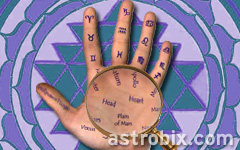Introduction to Palmistry Reading - How to Read Palms - History of Palmistry in India
 Man has been curious to know about his future since ages. He developed various branches of predictive sciences like astrology, palmistry and numerology to satisfy his urge to know about the happenings of future. Palmistry is an ancient branch of science which deals with the complete study of a hand for the characterization and prediction of future. It is also known as Chiromancy (also spelled as Cheiromancy).
Man has been curious to know about his future since ages. He developed various branches of predictive sciences like astrology, palmistry and numerology to satisfy his urge to know about the happenings of future. Palmistry is an ancient branch of science which deals with the complete study of a hand for the characterization and prediction of future. It is also known as Chiromancy (also spelled as Cheiromancy).
Its practice is not confined to any culture, region and religion. It is found all over the world with diverse cultural variations. Hence, there are numerous versions of the analysis done on various lines of palm and the other features of hand across various schools of this art. The individuals who practice this art are known as palmists, hand readers, palm analysts or chirologists.
History of Palmistry
Palmistry came into existence in Greece between 384-322 B.C from Aristotle who got a treatise from god Hermes which he gave to Alexander the Great(356–323 B.C). This great ruler took a keen interest in this art and analyzed the lines of the hands of his officers.
Hippocrates used palmistry in diagnosing the diseases of his patients. This art spread to India, Tibet, China, Persia, Egypt and to some countries of Europe from Greece. Many ancient communities which made a remarkable contribution to this art were Sumerians, Tibetans, Hebrews, Babylonians, Egyptians and Persians.
Many intellectuals argue that Palmistry was born in India. Valmiki, a Hindu sage wrote a book on male palmistry which consisted of 567 paragraphs. It is thought that this art spread to China, Tibet, Egypt and Persia through India. Hence, the famous names in Palmistry were Aristotle, Alexander the Great, Hippocrates and Cheiro. Cheiro wrote several books on palmistry and is known is known as the father of Palmistry.
Palmistry Methods
There are innumerable versions of the interpretation in Palmistry across the various forms of this art. But, few steps are followed all across the world. A good palmistry practitioner should analyse every line (heart line, life line etc), every mount (or bumps), each intersection of line, the relative shapes and sizes of fingers, colour of the skin of palm etc.
A palm reader begins the analysis by examining both the hands. The left hand of a right-handed person is considered the ‘birth-hand’ which represents the inherited characteristics of that individual or his subconscious mind, while the right hand of that individual represents his conscious mind which includes characteristics like his identity, flexibility and his caliber. This condition is opposite for a left-handed person.
Palmistry - Shape of Hands
The shape of a hand is the first clue to analyse the overall character of a person. A palm reader can analyse various characteristics of a hand like relative shapes and sizes of fingers, colour of the skin of palm etc depending upon the school of astrology. Despite of all the diversities, the present-day palm readers use the following classifications:
- Square Hand - A square hand can be recognized by a large palm and long rough fingers which tell that the individual is an influential, practical, dominating and an authoritative person surely capable of achieving success.
- Narrow Hand - A narrow or tapering hand can be recognized by a rectangular palm and long thin fingers which show that the individual is creative and is an artist. He will be sensible and enthusiastic.
- Flat Hands - A flat or a spade-like hand can be characterized by an extensive palm and long flat fingers which tell that the individual is restless, energetic and dynamic.
- Pointed Hands - A pointed hand can be characterized by a long, oval palm and long and lean fingers which describe the person as an idealist and a sensitive lover.
- Knotty Hands - A knotty hand can be characterized by long, thin knotted fingers and belongs to a thinker or a philosopher.
The shape of hands of many people is mixed exhibiting combined characteristics. The mixed characteristics represent a moderate personality. A good palmist should study all the signs of a hand before reaching to a conclusion. However, the prediction made depends upon the infinite criterion a palm reader takes in consideration while studying a hand.






